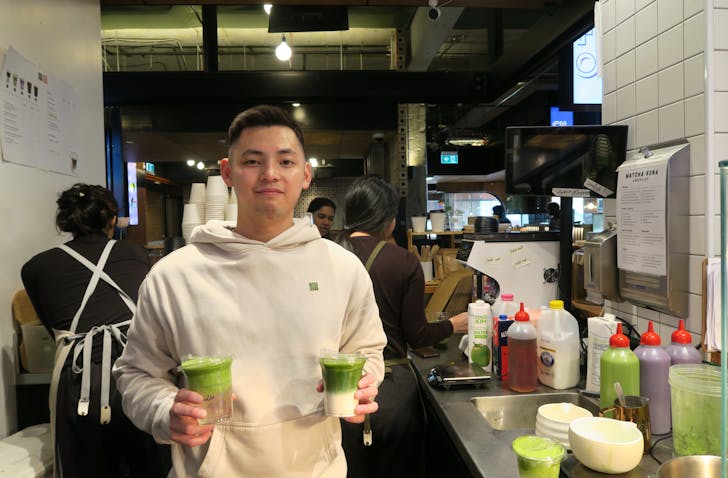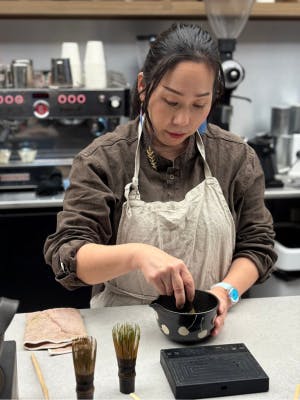Is Ceremonial Matcha Better Than Premium? Not Always, Especially For Your Morning Brew
Tara Zaw eyes the barista as whisked matcha spills into a glass of oat milk.
It’s paler than she hoped—an instant red flag. As the founder of Melbourne Matcha Girlies on TikTok, Zaw knows what she’s looking for.
Still, she takes a sip with her friend. They share a glance, wincing in agreement.
“Should we stop past Naau on the way home...?” Zaw suggests, hoping to salvage her now-sour mood with a latte from her CBD go-to.

Matcha—the ancient emerald jewel of Japan—has exploded in popularity in Melbourne, with dedicated cafes popping up across the city. But as aficionados know all too well, not all matcha is created equal. Flavour and quality depend heavily on both the cultivar and how it’s prepared.
“I feel disappointed that so little care and knowledge goes into making these drinks,” Zaw says.
A quick search for Melbourne’s best matcha on TikTok or Instagram pulls up videos of Zaw visiting new spots—many of them delivering less than satisfactory brews.
As more consumers clue in, bland, grassy lattes just don’t cut it anymore. Now, she and a growing community of local matcha devotees are calling on cafés to lift their game—and give matcha the same reverence Melbourne already gives its coffee.
For Urban List’s top picks on where to get a matcha in Melbourne, head over here.
Why Most Matcha Lattes Miss The Mark
Matcha Kona at RMIT University was one of the early adopters in Melbourne’s wave of matcha-specialist cafes two years ago. Since opening, owner Eddy Tjandra says matcha latte consumption at the cafe has surged by 300 to 500 per cent.
Tjandra’s local sales mirror a global trend. According to a Grand View Research report, the matcha market is projected to hit $11.4 billion, up 7.9 per cent from its 2023 value.
Despite its rising popularity, matcha remains a niche product limited by its harvest cycle, which occurs just three to four times a year.
To keep prices student-friendly, Tjandra relies on a longstanding relationship with a matcha supplier in Fukuoka, whose identity he keeps under wraps. But that might soon be tested: he’s been warned of an impending price increase in June due to supply shortages. His menu may soon reflect the spike.
But high prices don’t always equal high quality. “Unfortunately, the cafe scene in Melbourne is all about branding,” Tjandra says.

“People assume that if they’re paying a premium, the matcha must be good—but more often than not, they’re disappointed.”
That disappointment, according to Sayaka Matsuki—supplier at Trusty Matcha—often stems from cafes jumping on the matcha trend before understanding what they’re actually serving.
“Different grades of matcha have specific flavour profiles, brewing methods, and ideal uses,” she explains.
At the top of the quality scale is ceremonial grade matcha, known in Japan as Ichibancha. It’s the first harvest of spring, made from only the youngest, most tender leaves. The result is a naturally sweet, silky powder prized for its nutritional density and umami flavour.
Retailing at around $40–55 per 30 grams, ceremonial grade matcha is considered a luxury in Japan, traditionally reserved for tea ceremonies and special occasions. It’s prepared as usucha, a thin tea made with just water and matcha—no milk, no syrup.
“It’s such a waste to use ceremonial grade to make sugary matcha lattes,” Matsuki says.
Misusing Matcha’s Most Prized Grade
The West’s obsession with matcha—and its prized ceremonial grade—has created a persistent misconception: that it makes the best matcha latte.
But that’s not quite right, says David Lyons, director of the Australian Tea Cultural Society.
“There's an absolute lack of education,” he explains. Ceremonial grade matcha is now being sought by both cafes and consumers, but few understand its purpose.
From a food chemistry standpoint, “there is actually zero point using high-grade matcha with milk,” Lyons says. The composition of milk dulls the very qualities that ceremonial matcha is prized for: its sweetness, umami and delicate aroma.
Worse still, Lyons argues, is the loss of cultural meaning. “The whole cultural aspect is being lost because of fashion,” he says, as ceremonial matcha is used increasingly outside its intended context.
Yuko McClare, manager of Matcha Kobo—Melbourne’s first matcha-specialist cafe to stone-mill Uji matcha in-house—agrees that its deep historical significance is often overlooked.

At Matcha Kobo, staff aren’t allowed to whisk matcha until they’ve absorbed the traditions of the Japanese tea ceremony.
This approach reflects the spirit of 一期一会 (ichigo ichie)—a philosophy of treasuring each encounter as unique.
“We may never see this guest again,” McClare explains, “so we offer them our very best hospitality (omotenashi).”
Harumi Oshitani, Japanese Tea Ambassador to Australia and certified tea instructor, echoes the sentiment. She says a good matcha begins with honouring traditional techniques—like using 80°C water to avoid burning the tea, and whisking in a zig-zag motion with a bamboo chasen to achieve the ideal froth and texture.
“To enjoy matcha,” Oshitani says, “is to respect its preparation—and the centuries of culture behind it.”
The Making Of Matcha & Its Hierarchy Explained
Matcha comes from the same plant as green tea, but the leaves are grown under shade for three to four weeks before harvest—a process that preserves their vibrant green colour and boosts their nutrient profile. After harvest, the leaves are steamed to prevent oxidation, then dried.
From there, production becomes painstakingly precise. Stems and veins are removed by hand, leaving behind only the soft leaf flesh known as tencha, which is then stone-milled into the fine green powder used to make matcha.
Each harvest throughout the year differs in flavour and character, depending on exposure to sunlight. As Oshitani explains, each grade serves a different purpose. Nibancha—the second harvest—is typically classified as premium grade and is ideal for daily use in lattes.
While ceremonial grade matcha is prized for its consistency and complexity, sourcing good premium grade is a tougher task. Tjandra says he taste-tests at least 50 samples before settling on one that meets his standards. Cultivar, terroir, and harvest timing all shape the final flavour profile.
“We’re lacking good premium matcha,” adds Zaw, who suggests that sourcing better premium options could reduce demand for ceremonial grade—and offer a more affordable, sustainable alternative for cafes and consumers alike.



